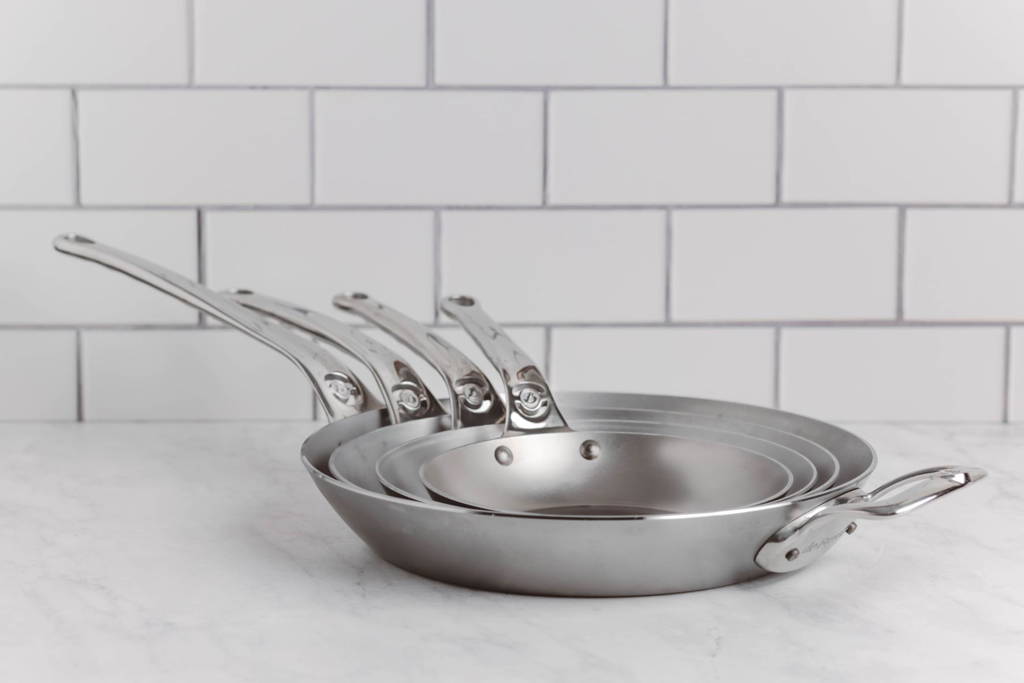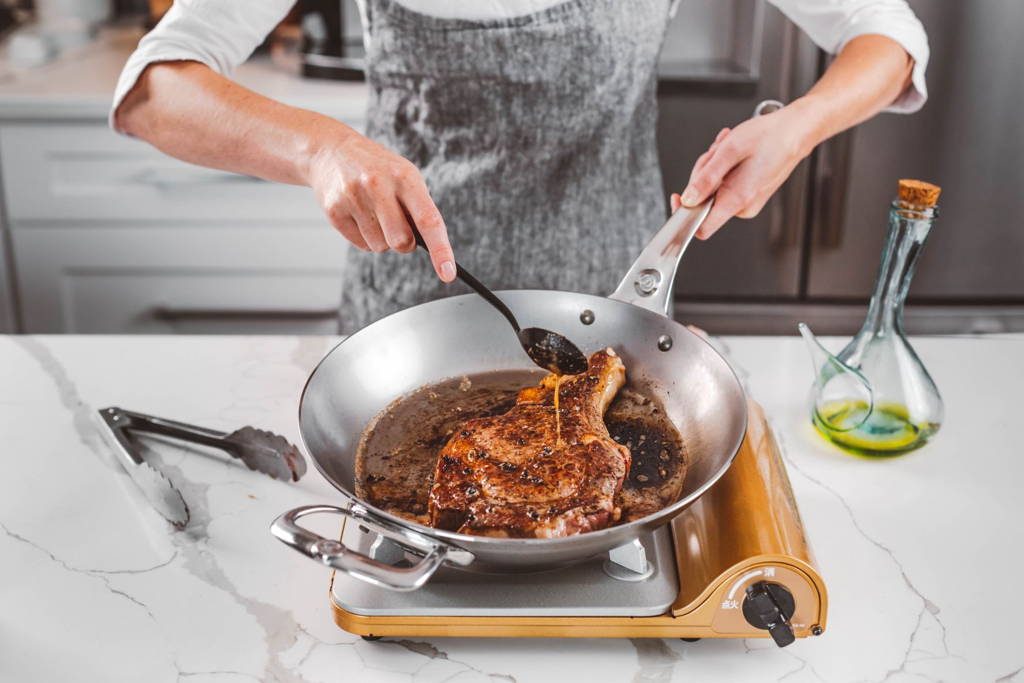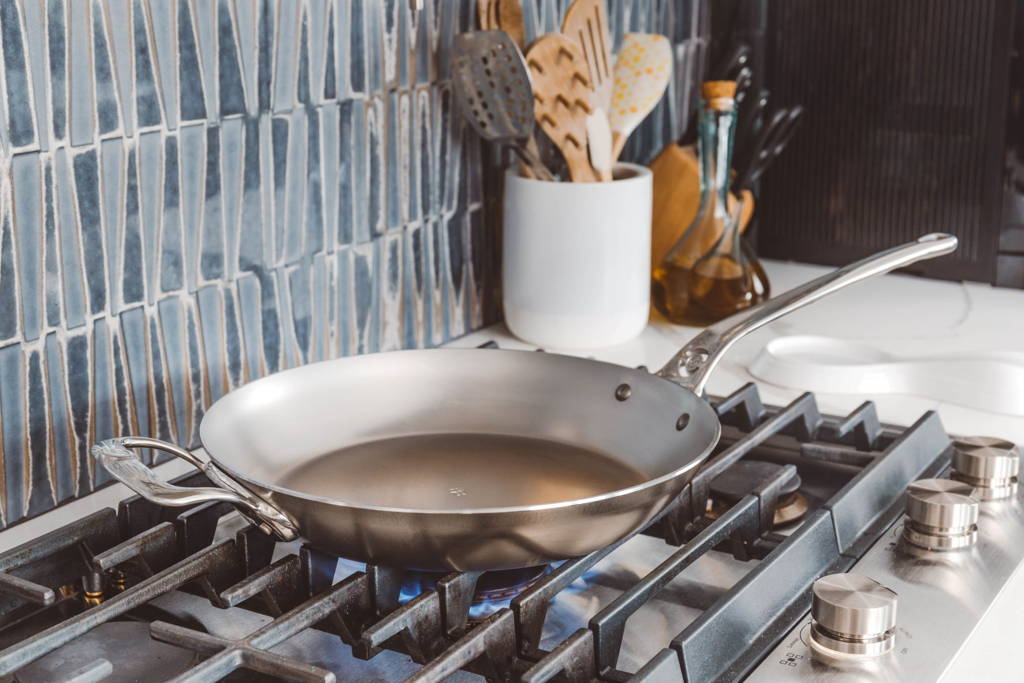Popular among kitchen professionals, carbon steel pans should be a staple in any home kitchen. They are perfect for getting that crispy skin on chicken and delicate enough to make the creamiest scrambled eggs. Compared to their main rival, the cast iron, carbon steel pans are 40% lighter with a wonderfully smooth cooking surface, making them more versatile in use. They do share one main thing in common though: they must be seasoned.
Whether this is the first time you are hearing the phrase “seasoning” or is something you may be familiar with, we hope this article helps explain some unanswered questions you may have. Whether you’ve only recently purchased your first carbon steel pan or are looking to learn more, below you will find information to help you understand what “seasoning” is, which pans need to be seasoned, and the differences between a natural vs regular nonstick coating.

What is "Seasoning"?
Seasoning is well known in the cast iron world, but it is equally as important for carbon steel pans. So, what is “seasoning”? Simply put, it is heating your carbon steel pan with a thin layer of oil in order to create a reaction that will produce a naturally nonstick layer that also helps to protect the material from rusting.
To season a pan, a thin layer of neutral oil with a high smoke point is added to the cooking surface of a clean pan. Then, the pan is heated over medium-high heat, or in the oven, until past the smoking point of the oil. By heating the oil past its smoke point, a chemical process called polymerization takes place transforming the oil from a liquid to a hardened, naturally nonstick layer. This process of polymerization creates a protective surface on your pan and will appear a bit shiny and dark in color. Please note, it is ok if the entire surface does not turn black; with time and use the overall color of the pan will darken.
Many think that we season our pans solely for the nonstick benefits, but seasoning carbon steel and cast iron pans also protect the pans against rust. When unseasoned carbon steel or cast iron pans are stored in wet or humid environments they can easily rust. The layer created by seasoning the pan prevents rust from forming by safeguarding the pan. However, even if you pan is well seasoned, we still recommend thoroughly drying it before storing it away.
A few notes on oils to use for seasoning your carbon steel pan:
• Be sure to use an oil that has a higher smoke point than the temperatures you will be typically cooking at.
• Oils with a higher amount of unsaturated fats are best for polymerization.
• Some prefer to use a neutral flavored oil when seasoning your pan. Although it may not impart flavor on your food, why take the risk? They also tend to be less expensive.
Be sure to check out our seasoning instructions to learn how to properly season your carbon steel pan.

'nonstick' pans vs. 'natural nonstick coating'
Above we kept mentioning that seasoning creates a layer that is naturally nonstick. While that sounds great, let dive a bit deeper into what it actually means and why it could be beneficial to use a seasoned carbon steel pan over buying a traditional nonstick pan.
What we think of as “nonstick pans” are sold with an engineered nonstick coating made of a variety of materials such as ceramic, silicon, superhydrophobic, polytetrafluoroethylene (PTFE), or enamel. Each of these coatings warrant individual articles discussing their pros and cons but for the purposes of comparing them to a natural nonstick coating – they are made from a variety of substances and added to the pans during production. Although we love these types of nonstick pans and they absolutely have a place in our kitchens, they tend not to last as long (especially with improper use and care), and there are hazards that come along with certain materials.
A properly seasoned carbon steel pan, however, has a natural nonstick coating that is created through the seasoning process. If cared for properly and seasoned as needed, these pans can last a lifetime and remain nonstick without the use of harsh materials, chemicals, or plastics. As discussed, this coating comes from simply heating oil to create a chemical reaction. Favored by chefs, seasoned carbon steel pans are so versatile that they can delicately fry eggs, create the perfect sear on meat, or even bake a cake.

Do all types of pans need to be seasoned?
Simply, the answer is no, not all types of pans have to be seasoned. All pans, however, can be seasoned if you wish. Wait, what? Confusing, I know. Let’s get one thing straight, seasoning a carbon steel pan is necessary for optimal use and care. As for other types of pans, seasoning can be helpful but is not necessary. Let’s walk through a few.
Nonstick pans – given that these are already nonstick, they do not need the added seasoning. It may, however, help the nonstick coating last longer.
Stainless steel pans – stainless steel pans can benefit from being seasoned because it may help provide some nonstick abilities. Stainless steel, however, does not require the protection against rust that seasoning provides carbon steel and, therefore it is not necessary to season steel.
Copper pans – like stainless steel pans, seasoning can help create a nonstick layer since it is often lined with a stainless steel layer but is not needed to protect copper against rust. Copper instead should be cleaned and occasionally polished to keep it looking shiny and like-new.
*Please note, there may be different steps to seasoning other type of cookware so be sure to do a little homework beforehand should you choose to season them.

There you have it, the truth behind what “seasoning” is, why your carbon steel pan needs it, and how it creates a natural nonstick surface that also protects against rust. Being multipurpose and light, you’ll find yourself grabbing for your carbon steel pan day after day. Be sure to get the most out of it by correctly seasoning and maintaining it!
